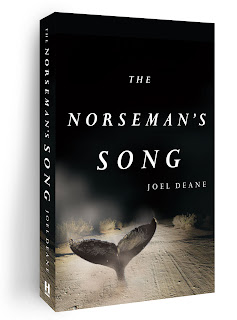The Norseman’s Song
By Joel Deane
The Norseman’s Song is a novel that seems packed with literary homage and allusion – to Edgar Allan Poe’s The Narrative of A. Gordon Pym, Joseph Conrad’s Heart of Darkness, Herman Melville’s Moby Dick, and even to Catullus’s poem 85, (known as ‘Odi et amor’). But for all of this intertextual reference, The Norseman’s Song is ultimately a page-turning thriller, albeit one with an unusual, inventive structure.
Deane cleverly weaves together multiple narratives from multiple narrators. The bulk of the story is about a Taxi driver named Farrell (and, fittingly, he is quite feral), who picks up an elderly and seemingly delusional man named Bob. Not only is Bob in possession of a box that contains a human face, but also he is searching for a shadowy figure called the Norwegian – a man alleged to have slaughtered his own wife and daughter on a whaling ship. Bob slowly reveals how he first came into contact with the Norwegian just after WWI (and exposes much of his own dark past in the process). This contemporary narrative is interspersed with excerpts from the Norwegian’s journal, which has apparently been bound in human skin, and recounts his own mad and bloody history. In this sense, the story is a record of multiple voyages: the Norwegian’s life aboard whaling ships, Bob’s story of his first search for the Norwegian, and Farrell’s contemporary taxi journey through Victoria.
The book also abounds with gothic imagery and gruesome violence, but, thankfully, Deane imbues even the grimmest moments with a bleak, absurdist sense of humour. The novel is at its best in its second half when it revels in its own gothic excess, pushing the genre into a kind of kitsch: Bob relates a string of increasingly ridiculous anecdotes, the best of which involves the story of two farmers who believe their sheep are being bayoneted by communists living on the edges of their property.
These moments don’t necessarily signify anything larger, but they aren’t meant to; while the reader needs to completely suspend any sense of disbelief in order for the novel to work, Deane is clearly in on the joke, parodying the schlocky language characteristic of noir and gothic fiction, such as when Farrell notes that, ‘I feel small. Exposed. Like a cartoon character just before the piano drops on his head.’
At other points, Deane’s overblown language ultimately does feel like overkill, however. The Norwegian’s journal entries are clearly intentionally bombastic (e.g. ‘it was plain for all to see through the permutations of his expression, from expectant to inchoate to corybantic, that his second wife had been as unfaithful as his first’), but, even though they are a sort of ironic pastiche, their grandiloquent prose can occasionally become tedious.
But this doesn’t really matter: The Norseman’s Song ultimately isn’t a novel that’s attempting to offer some contemplative, literary experience. It presents bracing action recounted through a clever narrative structure. Sure, if you step back and think about it, some aspects of the plot don’t quite tally, but neither, for that matter, do most Phillip K. Dick novels. Moreover, one suspects that Deane has wilfully avoided such narrative closure, much as Poe did in his strange and fragmentary The Narrative of A. Gordon Pym – a key influence. Ultimately, The Norseman’s Song is a keen, clever piece of entertainment, and if you’re looking for a cleverly told yarn, it will certainly fit the bill; without a doubt, this will be one of the sharpest, most intriguing Australian thrillers released this year.




No comments:
Post a Comment